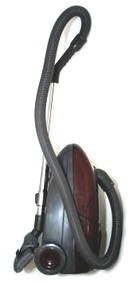Vacuum cleaner?
Let start by the beginning! Everybody knows what a vacuum cleaner is, but here's its story.
History
 The first manually-powered cleaner using vacuum principles was the "Whirlwind", invented in Chicago in 1868 by Ives W. McGaffey. The machine was lightweight and compact, but was difficult to operate because of the need to turn a hand crank at the same time as pushing it across the floor. It was sold for $25, a high price in those days.
The first manually-powered cleaner using vacuum principles was the "Whirlwind", invented in Chicago in 1868 by Ives W. McGaffey. The machine was lightweight and compact, but was difficult to operate because of the need to turn a hand crank at the same time as pushing it across the floor. It was sold for $25, a high price in those days.
McGaffey was but one of many 19th-century inventors in the United States and Europe who devised manual vacuum cleaners. The first patent for an electrically driven "carpet sweeper and dust gatherer" was granted to Corinne Dufour of Savannah, in December 1900.
The first powered cleaner employing a vacuum was patented and produced by Hubert Cecil Booth in 1901. Booth created a large device, known as Puffing Billy, driven first by an oil engine, and later by an electric motor. It was drawn by horses and parked outside the building to be cleaned.
Booth started the British Vacuum Cleaner Company and refined his invention over the next several decades. Though his "Goblin" model lost out to competition from Hoover in the household vacuum market, his company successfully turned its focus to the industrial market, building ever-larger models for factories and warehouses.
In 1905 "Griffith's Improved Vacuum Apparatus for Removing Dust from Carpets" was another manually operated cleaner, patented by Walter Griffiths Manufacturer, Birmingham, England. It was portable, easy to store, and powered by "any one person (such as the ordinary domestic servant)", who would have the task of compressing a bellows-like contraption to suck up dust through a removable, flexible pipe, to which a variety of shaped nozzles could be attached. This was arguably the first domestic vacuum-cleaning device to resemble our modern vacuum cleaner.
In 1904, James Murray Spangler, a janitor in Canton, Ohio invented an electric vacuum cleaner from a fan, a box, and a pillowcase. In addition to suction, Spangler's design incorporated a rotating brush to loosen debris. His vacuum sold under the name 'Model O' with a price of about $60.
Spangler patented his rotating-brush design 1908, and eventually sold the idea to his cousin's husband's "Hoover Harness and Leather Goods Factory." In the United States, Hoover remains one of the leading manufacturers of household goods, including cleaners.
For many years after their introduction, vacuum cleaners remained a luxury item; but after World War II they became common among the rising middle classes.
Some parts of this page and others are
from Wikipedia.

 The first manually-powered cleaner using vacuum principles was the "Whirlwind", invented in Chicago in 1868 by Ives W. McGaffey. The machine was lightweight and compact, but was difficult to operate because of the need to turn a hand crank at the same time as pushing it across the floor. It was sold for $25, a high price in those days.
The first manually-powered cleaner using vacuum principles was the "Whirlwind", invented in Chicago in 1868 by Ives W. McGaffey. The machine was lightweight and compact, but was difficult to operate because of the need to turn a hand crank at the same time as pushing it across the floor. It was sold for $25, a high price in those days.